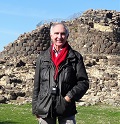


|
|
||||||||||||||||
|
|
||||||||||||||||
|
|
|||||||||
|
|
Italy Sardinia Barumini
Dating from the Bronze Age (1500 BC - 1200 BC) the ruins of Su Nuraxi developed over the subsequent centuries up to 600 BC when the site was destroyed and abandoned. It was subsequently restored by Carthage during its occupation of Sardinia and then occupied by the Romans before being completely abandoned.
The ruins were discovered in 1950 and excavation was carried out between 1950 and 1957, which highlighted the different stages of the construction of the towers and surrounding village. It also confirmed that the complex was a vibrant and important centre during the Roman period up to the first century BC.
The archaeological site of Su Nuraxi is located at Barumini, in the Province of South Sardinia about 50 kilometres north of Cagliari. The complex was very advanced for its time and consisted of a number of towers that were joined by curtain walls and surrounded by a collection of the remains of a village. It consists of a central tower with three overlapping chambers, the first two of which are still preserved, and the third chamber has only the lower part intact. The whole tower is over 20 meters high and built of blocks of basalt. Within the tower are a number of rooms accessed by stairs to the different floor levels.
Around the central tower, there is a rampart with four towers, these are connected by a curtain wall. In the central courtyard, there is a well. This structure is believed to have been the first part of the complex, around this was added another seven towers which are connected by a curtain wall. Inside the towers are circular rooms conical in shape.
The towers, known as Nuraghe, are the main type of ancient megalithic edifice found in Sardinia. These developed between 1900 and 730 BC during what was the Nuragic Age. This was the time of the Nuragic Civilization which existed in Sardinia from the 18th century BC to the 2nd century CE.
Although it is accepted that the complex has a fortress-type function some archaeologists believe that it may have originally been for a religious purpose, or for the administration and government of the community, or as a refuge for the village chief. A village accommodating the surrounding population developed in the Late Bronze Age (1200 BC - 500 BC).
The village is located outside the perimeter of the towers and consists of around fifty huts built of dry stone walls, circular in shape. These would have been covered with a conical roof made of wood and branches. Other buildings have been identified as meeting places, workshops, and agricultural processing.
Visitors are able to explore the complex and modern stairways have been installed for this purpose, although parts can be difficult.
The complex was included in the UNESCO list of World Heritage Sites in 1997.
|
|
|||||||
|
|
|||||||||
All Photographs were taken by and are copyright of Ron Gatepain
| Site Map |
